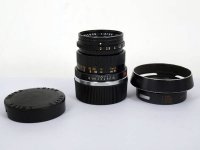dow
Member
Hi All,
So I'm researching which Summicron I'm going to (eventually) buy - and I was wondering why the black type 3 with the reversible hood seems to be the one that gets the least amount of love.
I like the lens as it reminds me ergonomically of my old (stolen! still bitter!) Leicaflex Summicron. The market seems to place nice examples complete with caps and hood around $750.
Any thoughts on this particular iteration of the summicron would be greatly appreciated. I searched the forum with Google to no avail - but if Im tilling plowed ground with this question just drop me a link and I'll be on my merry way.
In case I've got the number wrong - here's a pic of the lens I'm thinking of.
Thanks in advance as always,
Dow
So I'm researching which Summicron I'm going to (eventually) buy - and I was wondering why the black type 3 with the reversible hood seems to be the one that gets the least amount of love.
I like the lens as it reminds me ergonomically of my old (stolen! still bitter!) Leicaflex Summicron. The market seems to place nice examples complete with caps and hood around $750.
Any thoughts on this particular iteration of the summicron would be greatly appreciated. I searched the forum with Google to no avail - but if Im tilling plowed ground with this question just drop me a link and I'll be on my merry way.
In case I've got the number wrong - here's a pic of the lens I'm thinking of.
Thanks in advance as always,
Dow


